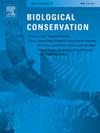有毒的鱼饵导致希腊北部的金雕死亡率创下纪录:呼吁采取紧急保护行动
IF 4.4
1区 环境科学与生态学
Q1 BIODIVERSITY CONSERVATION
引用次数: 0
摘要
尽管欧洲大型猛禽种群总体上有所恢复,但希腊的金鹰(Aquila chrysaetos)种群仍处于濒危状态。为控制食肉动物而非法设置的诱饵中毒是一个重要的死亡因素,影响了我们研究地区更广泛的鸟类食腐动物群落。我们分析了希腊北部过去35年的金鹰死亡率数据,包括过去十年29只卫星标记的个体的命运。中毒占总死亡率的65%,是全球鹰群中有记录的最高比例。来自遥测数据的已知命运生存模型显示,未成熟和成年的年生存率分别为0.78和0.85(遥测研究中报道的最低),在排除中毒死亡率后显着提高。中毒事件发生在保护区附近的比例不成比例,更经常发生在食肉动物大量捕食牲畜的地区,而且几乎只发生在鹰更可能觅食的冬季。金雕通常直接食用含有非法有毒物质(如呋喃和灭多威)的尸体和内脏饵料而中毒。触电是第二大死亡原因,与涡轮机的碰撞也有记录。我们的研究结果的主要保护意义是,迫切需要改变政策,以扭转种群数量的下降,主要是反对非法使用有毒诱饵,并在预防,立法和执法层面进行。为此,我们提出了完善畜牧业、加强野生动物犯罪侦查能力建设、改革相关立法等具体措施。本文章由计算机程序翻译,如有差异,请以英文原文为准。
Poisoned baits drive record golden eagle mortality in northern Greece: A call for urgent conservation actions
Despite an overall recovery of European large raptor populations, the golden eagle (Aquila chrysaetos) population in Greece is Endangered. Poisoning from baits set illegally for carnivore control is known as an important mortality factor, impacting a wider avian scavenger assemblage in our study area. We analysed golden eagle mortality data from northern Greece for the last 35 years, including the fates of 29 satellite-tagged individuals from the last decade. Poisoning accounted for 65 % of the overall mortality, the highest percentage recorded globally for any eagle population. Known fate survival models from telemetry data revealed 0.78 and 0.85 annual survival rates for immature and adults, respectively (the lowest reported in telemetry studies), improving markedly when censored for poisoning mortality. Poisoning occurred disproportionally close to protected areas, more often in areas with high carnivore livestock depredation and almost exclusively in winter when eagles were more likely to scavenge. Golden eagles were usually poisoned by directly feeding on carcasses and offal baits laced predominantly with illegal toxic substances (e.g. carbofuran and methomyl). Electrocution was the second cause of mortality, and collision with turbines was also recorded. The main conservation implication of our findings is that urgent policy changes are required to reverse the population's decline, mainly against the illegal use of poisoned baits and across prevention, legislative and enforcement levels. We propose specific measures towards this direction, such as improving livestock husbandry, further capacity building for wildlife crime investigation and reforms in relevant legislation.
求助全文
通过发布文献求助,成功后即可免费获取论文全文。
去求助
来源期刊

Biological Conservation
环境科学-环境科学
CiteScore
10.20
自引率
3.40%
发文量
295
审稿时长
61 days
期刊介绍:
Biological Conservation is an international leading journal in the discipline of conservation biology. The journal publishes articles spanning a diverse range of fields that contribute to the biological, sociological, and economic dimensions of conservation and natural resource management. The primary aim of Biological Conservation is the publication of high-quality papers that advance the science and practice of conservation, or which demonstrate the application of conservation principles for natural resource management and policy. Therefore it will be of interest to a broad international readership.
 求助内容:
求助内容: 应助结果提醒方式:
应助结果提醒方式:


